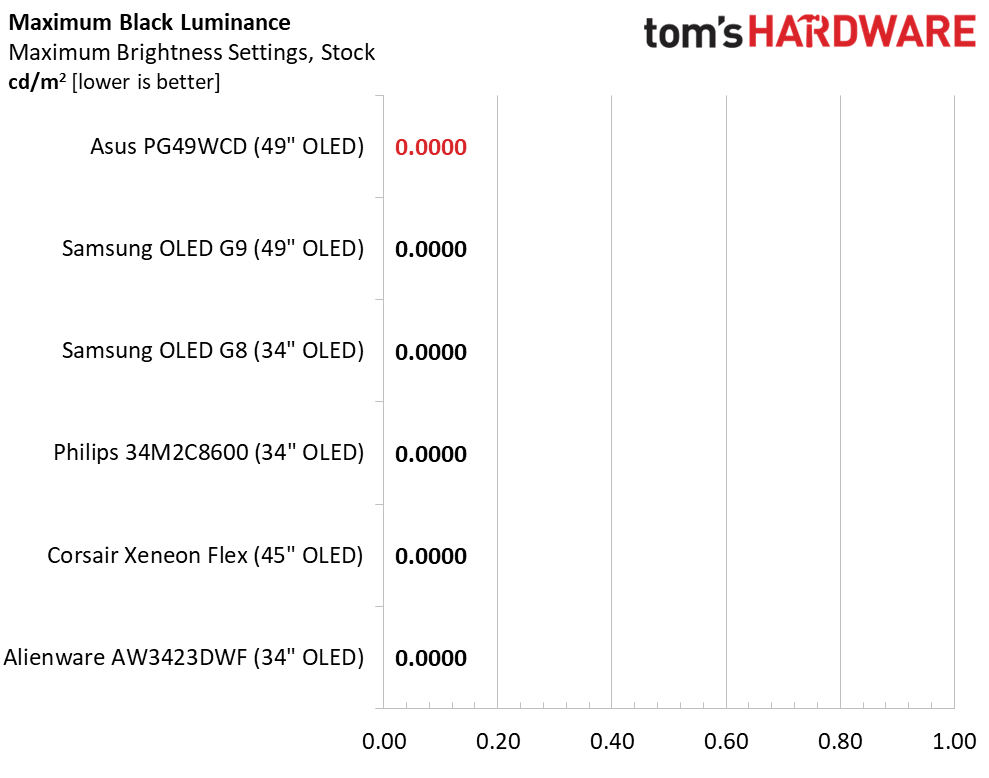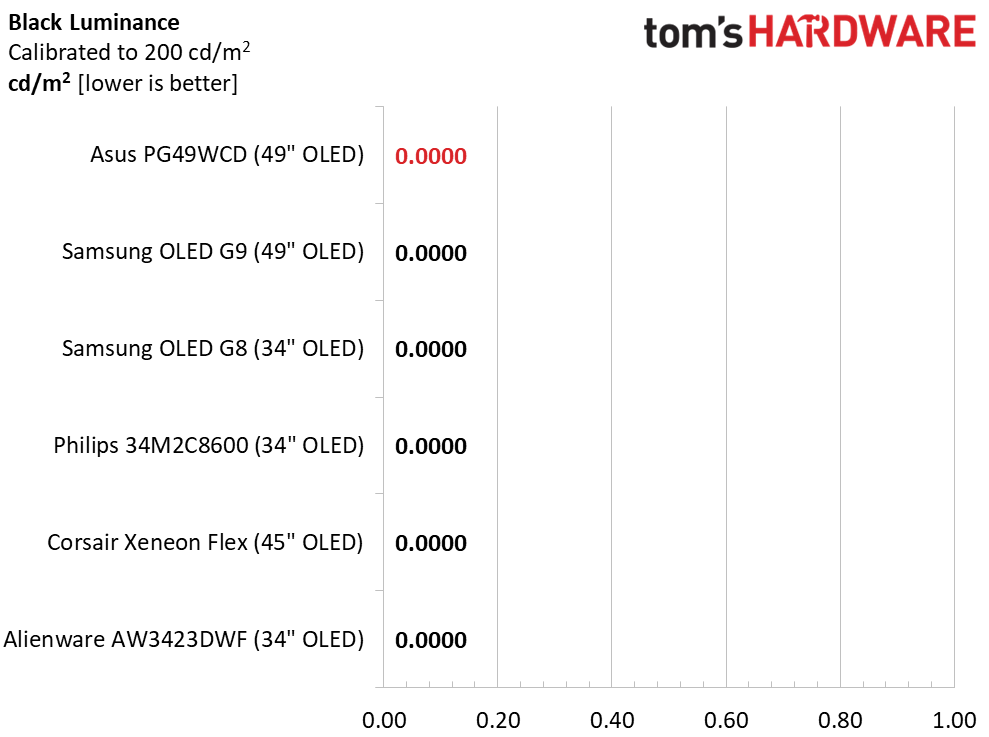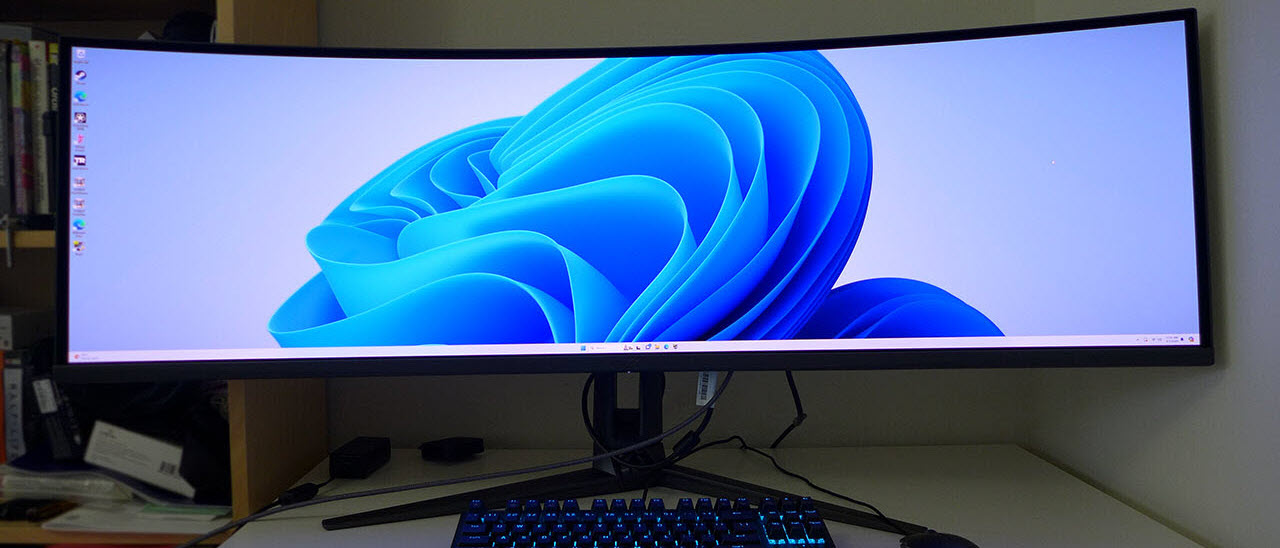Why you can trust Tom's Hardware
To read about our monitor tests in-depth, please check out Display Testing Explained: How We Test PC Monitors. We cover brightness and contrast testing on page two.
Uncalibrated – Maximum Backlight Level



The PG49WCD’s peak brightness numbers depend on whether the Uniform Brightness option is turned on. If it’s on, the peak is limited to around 250 nits. This is fine in a dark room, but with ambient lighting, I recommend turning it off. Then, I measured a 25% window pattern to just under 450 nits. That’s plenty of output for any indoor environment. Black levels are unmeasurable, and so is contrast. This is why I love OLEDs. And this is why they look better than LCDs.
After Calibration to 200 nits



Adjusting that same window pattern to 200 nits is fine for testing purposes as it levels the playing field. But I found that it was still a tad too bright. For my office, 175 nits was a more comfortable level. Your mileage will vary, so I recommend setting brightness to taste with Uniform Brightness turned off. If you use the PG49WCD in darkness, UB is a good option.
Any further contrast measurements are impossible thanks to the shutoff of all pixels receiving a 0% signal. It truly can’t get better than this.
Test Takeaway: The PG49WCD delivers the infinite/unmeasurable black levels that all OLEDs are famous for. This creates an image with depth and dimension superior to any LCD, even Mini LED models. If you want more brightness, yes, LCD tech is better. But for pure image quality, OLED is king.
MORE: Best Gaming Monitors
MORE: How We Test PC Monitors
Get Tom's Hardware's best news and in-depth reviews, straight to your inbox.
MORE: How to Choose the Best HDR Monitor
Current page: Brightness and Contrast
Prev Page Response, Input Lag, Viewing Angles and Uniformity Next Page Grayscale, Gamma and Color
Christian Eberle is a Contributing Editor for Tom's Hardware US. He's a veteran reviewer of A/V equipment, specializing in monitors. Christian began his obsession with tech when he built his first PC in 1991, a 286 running DOS 3.0 at a blazing 12MHz. In 2006, he undertook training from the Imaging Science Foundation in video calibration and testing and thus started a passion for precise imaging that persists to this day. He is also a professional musician with a degree from the New England Conservatory as a classical bassoonist which he used to good effect as a performer with the West Point Army Band from 1987 to 2013. He enjoys watching movies and listening to high-end audio in his custom-built home theater and can be seen riding trails near his home on a race-ready ICE VTX recumbent trike. Christian enjoys the endless summer in Florida where he lives with his wife and Chihuahua and plays with orchestras around the state.
-
edzieba For OLED panels (or LCD panels with backlight modulation) it'd probably be better to chart grey contrast rather than black contrast - the ratio between the maximum and minimum possible nonzero illumination level. Black contrast with a panel that can turn off a pixel/zone for 0-level will always end up with a divide-by-zero issue and a completely worthless chart. Grey contract (full brightness over minimum displayable brightness) actually gives you a useful measure of real world contrast.Reply
e.g. a screen that can produce 0 nits at 0 input level, 1 nit at an input level of 1, and 1000 nits at an input level of 255, will have much higher perceptual contrast than a screen that will also produce 0 nits at 0 input level, but produces 50 nits at an input level of 1 and 1500 nits at an input level of 255.
The naïve max-brightness-over-zero-level charts are about as helpful as the old 'dynamic contrast' measures manufacturers liked to slap on monitors with backlight modulation (where a TN panel could magically produce a 80,000:1 contrast ratio). -
brandonjclark How would you compare this monitor on "versus" comparison, buy this or that, to the Dell Alienware AW3225QF, readers?Reply -
oofdragon Why these companies keep wasting time and resource launching these huge things not up to date with tech? 144hz is like 10 years ago literally, the minimum now is 240hz or gtfoReply -
subspruce Reply
also this monitor needs 2 people for transport, getting a friend (if you haven't already) or a partner will be a great move if you ever want to move house.oofdragon said:Why these companies keep wasting time and resource launching these huge things not up to date with tech? 144hz is like 10 years ago literally, the minimum now is 240hz or gtfo
